Dishonored Review
 Game: Dishonored
Game: Dishonored
Developer: Arkane Studios
Publisher: Bethesda Softworks
Available on: Xbox 360, PlayStation 3, Windows PC
Reviewed on: Xbox 360
A great ship drifts by, her hull draped in lichen and seaweed, peppered with rust-holes that gape like angry wounds; atop her once-proud decks, a colossus is chained, black flesh snagged on man-sized barbs, held fast to be butchered while she still lives for the natural oil she produces; a fuel like no other over which man, always man, will war, and rage, and kill. Overhead, twilight paints the cream sky in shades of umber and ochre, and the chemical fumes of industry churn like dark grease splashed on water.
This is the scene that greets you as Dishonored begins, as you sit in a small battered boat, dwarfed by the towering whaling ships, drifting slowly back towards the city of Dunwall. Curnow, the officer who shares your boat, chatters as you travel, filling you in on backstory: You’ve been away a while, having travelled to the other Isles to beseech the rulers of their cities for aid against a horrific plague that has ravaged Dunwall and turned her beleaguered people against their once-beloved Empress. The scene is grim in its majesty, beautiful in its bleakness, and Dishonored maintains such themes throughout.
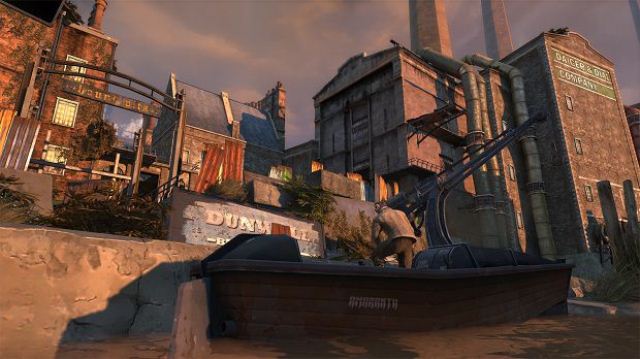
STORY: It is a time of plague in Dunwall. The Weeping Death is a horrific disease that spreads like wildfire, making its victims weep tears of blood before turning them into mindless wailing husks that stagger through litter-strewn alleys, attacking anyone and anything on sight. It originated in the bull-rats, large rodents that many believe are not natives of Dunwall, and has turned the city into a waiting room before the gates of Hell.
As Corvo Attano, Lord Protector to the Empress and her young daughter Emily, your first task is to deliver grim tidings to your ruler: The other cities won’t help, and instead intend to blockade Dunwall to study the effects and voracity of the Weeping Death. Barely moments after reading the letter, the Empress is attacked and brutally slain, Emily is taken and Corvo, despite his efforts to defend them, is arrested for the crime.
While the opening ten minutes act as a tutorial to stealth (playing a game of hide and seek with Emily in a moment of rare solitude) and combat (attempting to defend the Empress) the story truly begins six months later. Having been repeatedly tortured for a confession he refuses to give, Corvo longs for escape and vengeance – both of which are served by a group of loyalist rebels who free him so that he might depose the pretender to the Imperial throne and restore Emily. Aid also comes unexpectedly from the Outsider, a strange and enigmatic entity with his own agenda who gifts Corvo with supernatural abilities.
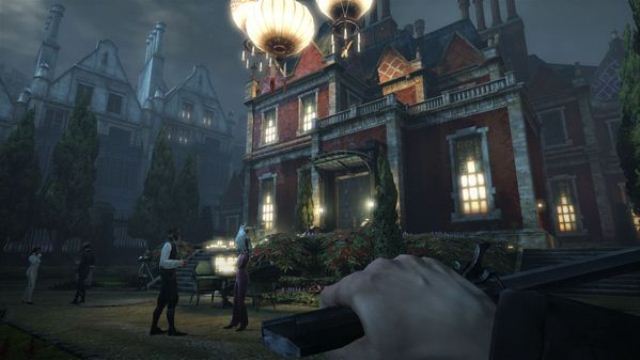
It’s fair to say that Arkane Studios have played it safe with Dishonored’s storyline. The tale of revenge and redemption is surprisingly straightforward, despite the presence of the Outsider and his magic, and twists are few and far between besides a couple of sucker punches towards the end. It’s an action game with an action game’s narrative and, as such, is uncluttered by excess characters, twists or filler quests; and it’s all the better for it.
GRAPHICS: Since its announcement, much has been made of Dishonored’s art style; and for good reason. The graphics may not be the cleanest and sharpest when compared to, say, Skyrim or Deus Ex: Human Revolution, but it’s a deliberate choice. Dunwall is like an oil painting, something Edward Hopper might have produced after an evening spent drinking absinthe with Jack the Ripper and Sweeney Todd. Characters are purposefully out of proportion, either thickly-built (as is standard for the Unreal Engine), or else adorned with severe physical attributes such as oversized hands or facial features.
Little visual details add layers to the rich atmosphere; sunlight gleams from gently rippling water and clouds of noxious smoke discolour the sky like dirty fingerprints. The creators have said that London circa 1666 was a jumping off point for the architectural design long before the addition of the whale-oil-powered, Tesla-like technology, and this is evident everywhere, but there’s a hint of gangland New York, too – particularly in criminal character Slackjaw who is clearly modelled on Daniel Day Lewis’ Bill the Butcher. Though not technically perfect, Dishonored is a visually beautiful game and the artistry effortlessly captures and projects the muck and muscle of Dunwall.
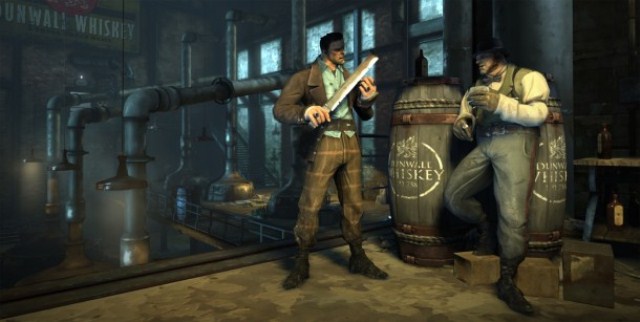
SOUND: Dishonored’s sound is as essential to the oppressive atmosphere of the troubled city as the artwork. An ever-present klaxon pierces the silence whenever you’re out on a mission, reminding you of curfew conditions, newly-changed laws and your own recent escapades via sinister public service announcements.
Stirring music picks up when you get into trouble, just to keep your heart racing, but the wonderful score is arguably underused. The scripting is great, however, as is the delivery, and incidental chatter from the guards or loitering gang members adds heaps of backstory and brings the uninviting streets to life, despite the lack of civilians on the cobbles (this is a city in the grip of plague and civil unrest, after all).
The biggest issue I have with the sound is Corvo’s lack of a voice. It might well be expected from a Bethesda game, and it might even be a deliberate omission to increase our immersion, but when the dialogue choices are so black and white (never more than dressed up yes or no answers), it seems almost like an oversight.

GAMEPLAY: Dishonored is presented as a series of missions chiselled into shape by the narrative. Corvo’s role is that of an assassin, despatched to kill key targets to undermine the Lord Regent’s coup. You’ll return to a safe-zone hub after each job where you can upgrade your gear and buy ammunition, or chill out and talk to the other Loyalists. It streamlines events, cuts out the filler, and presents Dishonored as a satisfyingly fat-free experience. Even side-quests act as part of the main missions, running alongside them or as prelude to them. For example, one side-quest sees you torturing an art dealer in a brothel to obtain the code to his safe, in order to persuade gang-leader Slackjaw to remove your targets in a non-lethal manner. It’s optional content, of course, but presented as such an intrinsic part of the mission that you want to complete it, just for the hell of it.
Almost immediately, Dishonored is reminiscent of a mix of high quality games. The opening half an hour screams Bioshock, the looting of scattered coins and unappetising food (skewered rat and a tin of rotting hagfish, anyone?) whispers Fallout 3. Combat, too, is a patchwork of new ideas and borrowed elements. In Corvo’s right hand is his butterfly-blade, lethally sharp and titanium strong, while in his left hand rests everything else. Powers such as Blink (a short-range teleport spell) and gadgets like the horribly-efficient spring-razor trap are selected from a power wheel and activated with the left trigger. For precision kills or sneaky takedowns, equip the crossbow and use the zoom function on Corvo’s iconic clockwork skull mask. For instant gratification but zero subtlety, go with the pistol. For messy explosions in a tight spot, lob a grenade. The options are impressive.
Beyond the gruesome gizmos, the presence of the Outsider brings a supernatural flavour to Dishonored’s eclectic cocktail of violence. There’s always an option to go down the silent, non-lethal route (a hidden mechanic tracks your Chaos rating based on bodies found, people killed and times you were detected but only presents your results after a given mission), and the magical abilities, as with the physical, facilitate any play-style: A swarm of rats can be summoned to kill enemies and dispose of corpses; time can be frozen while you make a getaway; you can even possess the bodies of people and animals. The only complaint against such a rich arsenal is that sometimes Corvo can seem almost over-powered, even in later missions against towering, mechanical Tall Boys and guards whose music boxes block your magic. Occasionally, enemy AI can seem a little off-kilter as one moment guards are as sharp as hunting dogs and the next run around like headless chickens, but such occurrences are rare and you’re kept on your toes – or on the edge of your seat – for the rest of the time. However you choose to play, Dishonored is a tour de force of game design brimming with brutal possibility.
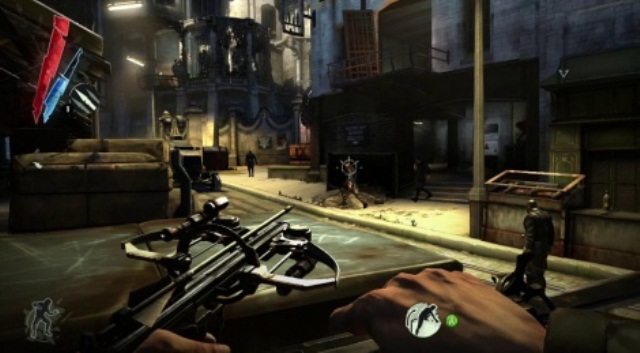
LONGEVITY: Although it isn’t open-world, the free-form nature of Dishonored’s gameplay means it could take you anywhere from 12 to 20 hours to complete, but it encourages and invites multiple play-throughs. Completing missions faster, without kills or detections, without raising alarms and without using magic are worthy challenges that won’t just earn bragging rights but massive satisfaction.
Runes that unlock and upgrade your powers are hidden around each mission area, alongside shards of whale bone that buff you in various ways as well as hidden paintings and shrines to the Outsider. Finding them all takes patience and perseverance, as does discovering the non-lethal solution to many of the missions.
Overall, Dishonored is excellent value for money, it’s a game that will last 60 hours not because of hundreds of quests, time-wasting role-playing jobs or a convoluted, multi-branching plot, but because you’ll simply want to play it for 60 hours.
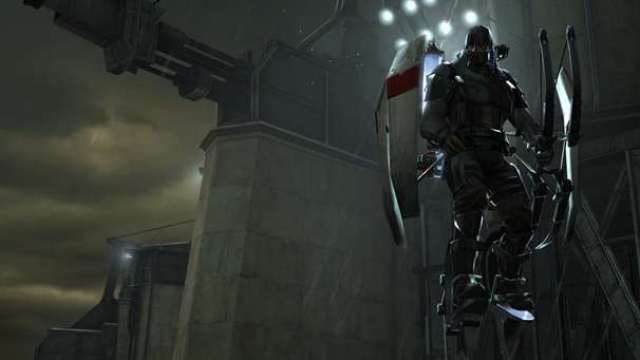
VERDICT: In a year that has already seen Mass Effect 3, Darksiders 2, Sleeping Dogs and Borderlands 2, it’s hard to label anything as number one, but Dishonored comes so close it’s agonisingly tough to call. A striking, evocative art style, a gripping, uncluttered plot, a city that acts as a dark mirror to our own inglorious past in a world where magic and industry collide with gruesome wonder and some of the most free-form gameplay we’ve ever seen combine to make Dishonored an absolute joy to play over and over again. Slight balancing issues and occasionally inconsistent enemy A.I. may threaten to undermine the quality, but, in the end, grow pale beside the overwhelming stack of positives. In short, Dishonored is a genuine masterpiece. Play it, love it, play it again, remember why you loved it.






